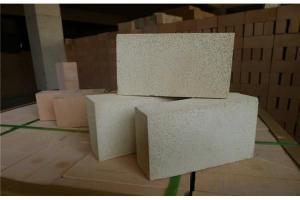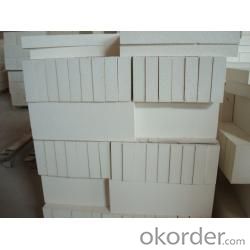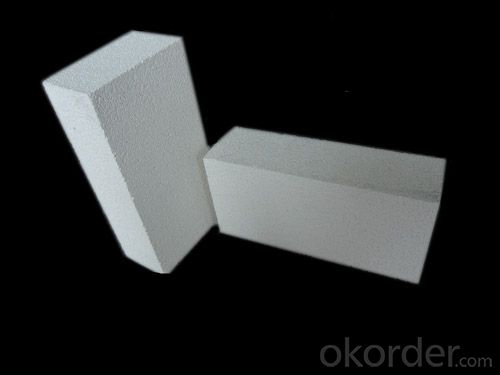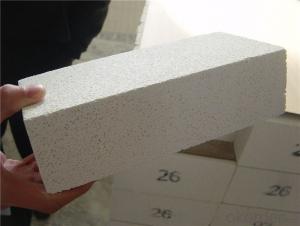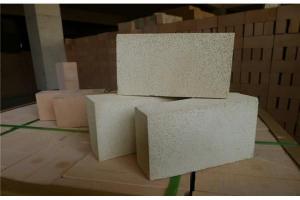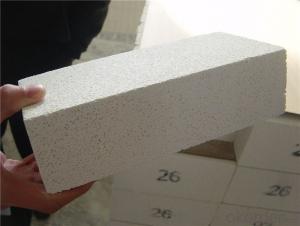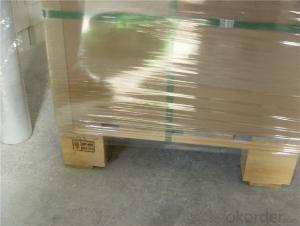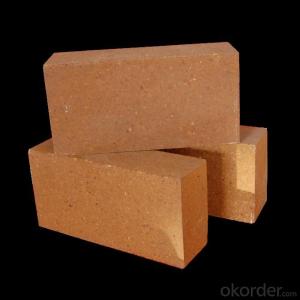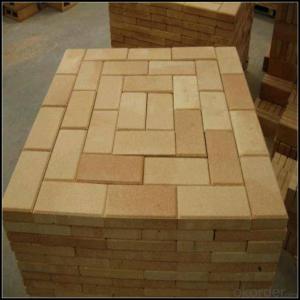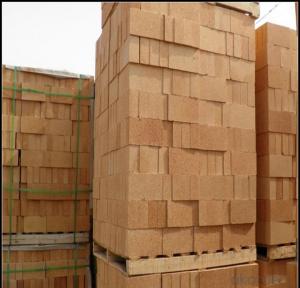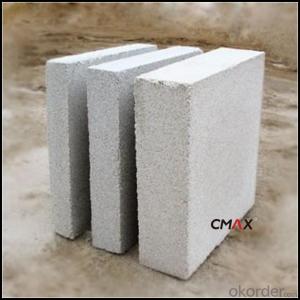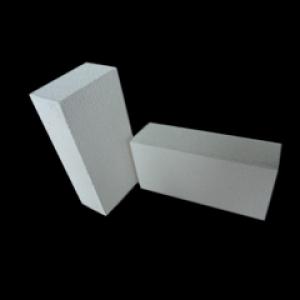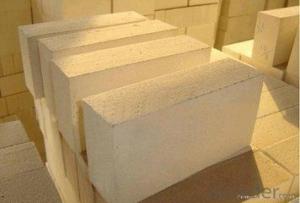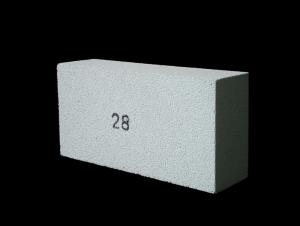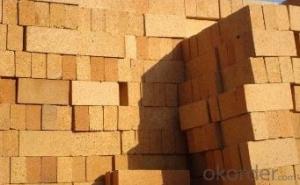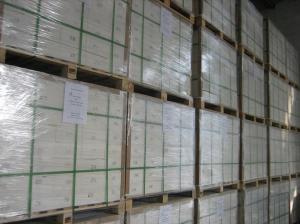Insulating Fire Brick for Fireplace
- Loading Port:
- Tianjin
- Payment Terms:
- TT OR LC
- Min Order Qty:
- 30 m.t.
- Supply Capability:
- 10000 m.t./month
OKorder Service Pledge
OKorder Financial Service
You Might Also Like
CNBM conforms strictly to the requirements of ISO 9000 quality control system during the production. MSDS is also available if you want. The thermal insulation fire clay brick meet with the requirements of ASTM & JIS standards. So pls stay cool with our quality.
Insulating Fire Brick Technical index
Product No. | IFB70 | IFB60 | IFB50 | IFB40 |
Al2O3 | 68%-72% | 58%-62% | 48%-52% | 38%-40% |
Refractoriness (°C ) | ≥1790 | ≥1790 | ≥1790 | ≥1790 |
Bulk density (g/cm3) | 2.50-2.60 | 2.35-2.45 | 2.20-2.30 | 2.10-2.20 |
Apparent porosity (%) | 22 | 19-22 | 17-20 | 17-20 |
Cold Crushing strength (kg) | 480-510 | 450-480 | 430-450 | 390-430 |
Application
Insulating Fire Brick are used for the lining of converter, alternating current arc furnace, direct Current arc furnace and the ladle slag line, etc.
Equipment
1 unit of Ceramic Abrasive (SG Abrasive) pilot production line
2 units of Compact grain Abrasive pilot production lines
1 unit of high-end coated abrasives (abrasive cloth) production line
2 units of Boron Carbide production lines
3 large flexible crushing and sieving lines for grit production lines
2 units of 2000KVA furnaces for Boron Carbide fusion
6 units of 5000KVA-10000KVA dumping type electric arc furnaces for Brown Fused Alumina fusion
Company Advantage
(1)Long Insulating Fire Brick manufacture history: 25 years manufacturer
(2)Advanced equipment
(3)Diversification of production standards: ISO ANSI FEPA JIS ASTM
(4)Flexible payment: T/T L/C D/P D/A
(5)Professional marketing team and after-sale service
(6)Free sample
FAQs
Q1 |
What’s the transport method? |
A1 | FCL delivery goods with wooden pallet or wooden case by sea; If LCL delivery, must with wooden case; Sometimes need open top, flat rack or bulk cargo. |
Q2 |
What’s the required payment term? |
A2 | Generally 30% TT as the prepayment, 70% TT before delivery. If need, 100% Irrevocable Letter of Credit or negotiation. |
Q3 |
Which country are our products exported to? |
A3 | Apart from entire Chinese market, the US, Russia, Japan, Korea, Australia and some Southeast Asian Nations. |
- Q: Can insulating fire bricks be used in incinerators?
- Yes, insulating fire bricks can be used in incinerators. They are designed to withstand high temperatures and provide excellent insulation, making them suitable for use in the intense heat of incinerator systems.
- Q: What are the different types of insulating fire bricks available?
- There are various types of insulating fire bricks available, each possessing unique characteristics and applications. Some of the most common types are: 1. Lightweight Insulating Fire Bricks (IFBs): These bricks consist of lightweight materials, such as expanded clay, perlite, or vermiculite, blended with a binder to create a porous structure. They offer exceptional insulation properties and find wide usage in applications where maintaining high temperatures is crucial, like in kilns or furnaces. 2. Mullite Insulating Fire Bricks: Mullite bricks are composed of a combination of alumina and silica, resulting in a material resistant to high temperatures. These bricks exhibit excellent thermal shock resistance and are frequently utilized in applications involving rapid heating and cooling cycles, such as in glass manufacturing or incinerators. 3. Alumina Insulating Fire Bricks: As the name suggests, these bricks are primarily made from alumina, which is highly resistant to high temperatures. They possess excellent thermal conductivity and are commonly employed in industries where maintaining high temperatures is essential, such as the iron and steel industry or ceramics production. 4. Silica Insulating Fire Bricks: Silica bricks are mainly composed of silica, a heat-resistant material. They exhibit exceptional thermal insulation properties and are commonly used in applications where maintaining high temperatures is necessary, like in the construction of kilns or furnaces. 5. Calcium Silicate Insulating Fire Bricks: These bricks are created by combining calcium silicate with other insulating materials. They possess excellent thermal insulation properties and are often employed in industries where maintaining high temperatures is crucial, such as the petrochemical industry or power plants. Ultimately, the choice of insulating fire brick depends on the specific requirements of the application, including temperature resistance, thermal conductivity, and thermal shock resistance. It is vital to select the appropriate type of insulating fire brick to ensure optimal performance and safety.
- Q: Are insulating fire bricks resistant to molten salts?
- Yes, insulating fire bricks are generally resistant to molten salts. These bricks are specifically designed to withstand high temperatures and offer excellent thermal insulation. They are often made from special refractory materials that have a high melting point and are chemically inert. Molten salts, on the other hand, are highly corrosive and can cause damage to many materials. However, insulating fire bricks are able to withstand the corrosive nature of molten salts due to their unique composition. Their dense structure and high refractory properties allow them to resist the corrosive effects of molten salts for prolonged periods. Furthermore, insulating fire bricks are often used in industries such as metal smelting, glass manufacturing, and chemical processing, where molten salts are commonly encountered. Their resistance to molten salts makes them ideal for applications involving these corrosive substances. However, it is important to note that the exact resistance of insulating fire bricks to molten salts can vary depending on the specific composition of the brick and the type of molten salt being used. Therefore, it is recommended to consult with the manufacturer or a specialist in refractory materials to ensure the suitability of insulating fire bricks for a particular application involving molten salts.
- Q: Are insulating fire bricks suitable for insulation in steam boilers?
- Yes, insulating fire bricks are suitable for insulation in steam boilers. Insulating fire bricks are made from lightweight materials that have high insulating properties, such as alumina or silica. They are designed to withstand high temperatures and thermal shocks, making them ideal for use in steam boilers where there is constant exposure to heat. Insulating fire bricks have low thermal conductivity, which means they can effectively prevent heat transfer, reducing energy loss and increasing the efficiency of steam boilers. Their high insulation properties also help to maintain consistent temperatures within the boiler, preventing heat fluctuations and minimizing the risk of thermal stress and damage. Furthermore, insulating fire bricks are resistant to corrosion and chemical attacks, ensuring their durability and longevity in steam boiler applications. They are also easy to install and can be cut into different shapes and sizes to fit the specific requirements of the boiler. Overall, insulating fire bricks are an excellent choice for insulation in steam boilers due to their ability to withstand high temperatures, low thermal conductivity, and resistance to corrosion. They help in reducing energy loss, improving efficiency, and ensuring the longevity of the boiler.
- Q: Can insulating fire bricks be used for insulation in residential walls?
- Insulating fire bricks are primarily designed for high-temperature applications, such as in kilns or furnaces. While they do provide excellent insulation properties, they are not typically recommended for use in residential walls. The reason is that insulating fire bricks may not meet the specific building codes and regulations required for residential construction. Additionally, there are other insulation materials available that are better suited for residential walls, such as fiberglass or foam insulation, which are more cost-effective and easier to install.
- Q: Can insulating fire bricks be used for insulation in chemical reactors?
- Insulation in chemical reactors can be achieved by utilizing insulating fire bricks. These bricks, made from lightweight materials like vermiculite or perlite, possess exceptional thermal insulation properties. They are specifically designed to endure high temperatures and can be applied in various scenarios, including chemical reactors. Chemical reactors often operate at heightened temperatures, making it crucial to maintain a stable temperature for efficient and safe functioning. By employing insulating fire bricks as insulation in chemical reactors, the loss of heat can be minimized, resulting in increased energy efficiency and cost savings. Furthermore, these bricks aid in reducing temperature variations within the reactor, ensuring even distribution of heat and enhancing overall performance. Moreover, insulating fire bricks exhibit resistance to chemical deterioration, enabling them to withstand the corrosive impact of different chemicals employed in chemical reactions. This quality makes them suitable for usage in chemical reactors frequently exposed to corrosive substances. To summarize, insulating fire bricks offer an exceptional choice for insulation in chemical reactors. They provide outstanding thermal insulation, endure high temperatures, and possess resistance to chemical attack. By utilizing insulating fire bricks in chemical reactors, improved energy efficiency, temperature stability, and overall reactor performance can be achieved.
- Q: Are insulating fire bricks resistant to thermal spalling?
- Yes, insulating fire bricks are resistant to thermal spalling.
- Q: Can insulating fire bricks be used in the construction of autoclaves?
- Yes, insulating fire bricks can be used in the construction of autoclaves. Insulating fire bricks are designed to withstand high temperatures and provide excellent insulation, making them suitable for use in autoclaves where high heat and pressure are involved.
- Q: Are insulating fire bricks resistant to high-velocity gases?
- In general, insulating fire bricks possess resistance to high-velocity gases. These bricks are specifically designed with high thermal resistance and low thermal conductivity, rendering them suitable for situations where exposure to elevated temperatures and gases is prevalent. Without experiencing any damage or compromise, they are capable of enduring the force and speed of gases. In the realm of industrial furnaces, kilns, and other high-temperature settings, insulating fire bricks find common application, as they fulfill the dual role of insulation and safeguard against high-velocity gases.
- Q: Can insulating fire bricks be used in chimney construction?
- Yes, insulating fire bricks can be used in chimney construction. Insulating fire bricks are designed to have low thermal conductivity, which means they are effective in reducing heat transfer. This makes them suitable for chimney construction as they can help to keep the chimney walls cooler and prevent excessive heat from transferring to the surrounding structures. Additionally, insulating fire bricks are lightweight and have good insulation properties, making them easier to handle and install in chimney construction. However, it is important to note that insulating fire bricks should be used in conjunction with other fire-resistant materials in order to meet safety regulations and ensure proper chimney construction.
Send your message to us
Insulating Fire Brick for Fireplace
- Loading Port:
- Tianjin
- Payment Terms:
- TT OR LC
- Min Order Qty:
- 30 m.t.
- Supply Capability:
- 10000 m.t./month
OKorder Service Pledge
OKorder Financial Service
Similar products
Hot products
Hot Searches
Related keywords
